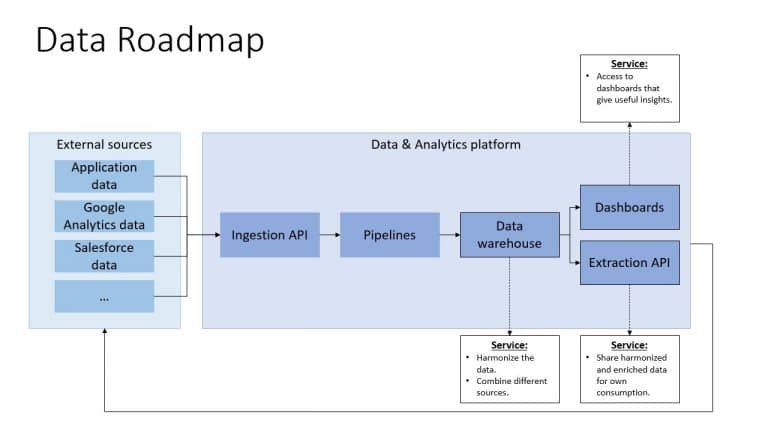Our client, a financial services provider, wanted to enhance their ability to convert data into business value. Using data engineering, we built a centralised platform on Azure that combines data from multiple product streams and delivers automated analytics and business intelligence solutions. This will allow them to achieve a single unified view of their customers based on the data from their diverse technology investments.

The Challenge
Our client, a financial services provider, has an internal central innovation team that is composed of multiple teams working on pioneering projects. This includes building applications and tools to be used by their customers. However, these products were not always being used to their full potential to convert the maximum amount of data into business value for the rest of the organisation.
Since each team works on separate products, there was a lack of cross-communication resulting in siloed data. With individual data analytic opportunities being limited, it was difficult for the central innovation team to get a good overview of how each product was doing. Is it profitable? Does it create impact? We helped them lay the foundation to answer these questions by setting up an environment in Azure where all the data from the different initiatives can be stored together.
The Approach
We divided the project into two phases. The first phase focused on building a minimum viable product that demonstrates direct results and a solid base for further extension. Phase Two of the project will further develop and scale-up the platform. The overall goal is to extend the platform to multiple initiatives, allowing the organisation to maximise its insights from the data.
Our team started Phase One with a design sprint to determine the main challenges of the central innovation team and find our use cases. The next step was to build a data warehouse in Azure. This acts as a single platform where all data is collected and stored. Additionally, we built APIs that connected the data from the team’s initiatives to the new data warehouse.
Furthermore, having an experienced data engineer, Vivienne (ADC Senior Consultant), on the project was critical to its success. Although our client has a team of developers with technical knowledge, they do not have someone who specialises in data engineering. A data engineer was essential to set up the data model, build the data pipeline, and insert the data into the Azure database.

A mock-up of the solution‘s architecture. In the project we worked iteratively, ensuring that each stage of the solution is functional and already delivers value while building towards the displayed end state.
The Solutions
We extended the foundation of our solution into two dimensions. Firstly, deepening and broadening the data analysis, and secondly, scaling up the number of connected sources.
The analysis solution that we are building combines data from multiple product streams and delivers automated analytics and business intelligence solutions. Furthermore, the new dashboard will immediately show the business value of the platform.
Within the platform, every strategy initiative has its own layer with its own data. Since it is all stored within one Azure data warehouse, they can now also combine the data. Additionally, we connected Power BI, a tool that creates dashboards from the data, to extract insights. This gives the innovation team more control over how they use their data to create impact.
Impact for the Client
One of the greatest impacts is that our client can now maximise the business value of their data by creating dashboards on top of the analysis solution. Furthermore, they can see how products are performing, compare products, and have an overview of the entire central innovation team.
In addition, combining the data on a single platform allows the client to access in-depth, combined insights on their customers. This helps the organisation achieve a single unified image of their customers based on the central innovation team’s initiatives. By having this transparency, they can start to customise their services better, understand the touch points where customers interact with their organisation, and retain customers by designing an attractive consumer journey.
In the future, this project will set their organisation up to do more with data science and machine learning, since having a platform is beneficial when building models. They can now use all their data in the model, as opposed to including the data of only one initiative.
Learnings Going Forward: Phase Two
Following Phase One, we recognised that adding a strategy expert was necessary to extend the platform to multiple initiatives. Anja (ADC Strategy Project Lead) brought an agile way of working. For example, sticking to the scrum ceremonies and asking the necessary questions. How do we design the backlog? How does the backlog connect to our sprint goal? Does it connect to our project goal? Having clear answers from the start ensures that we can follow through on these aspects of the project.
Additionally, we are working with our client to help them articulate the value proposition internally by demonstrating the opportunities created by the platform. This is necessary to gather internal partners who want to be involved with the project and provide their data for the platform. From there, we can start developing new use cases that go beyond dashboarding.
Let’s shape the future
Do you want to know more? Get in touch with Kevin Hanemaaijer of Amsterdam Data Collective, or check our contact page.

Related Cases
What stage is your organisation in on its data-driven journey?
Discover your data maturity stage. Take our Data Maturity Assessment to find out and gain valuable insights into your organisation’s data practices.






